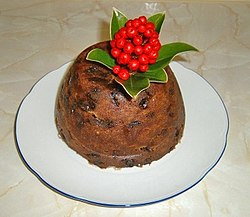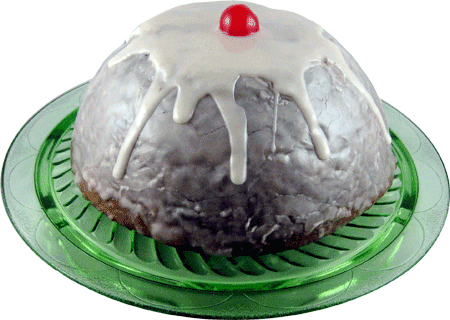This was a very busy year for news both entertainment wise and "real world" wise.
~ Republicans still don't have a clue who may get the nomination. (Its hard to pick a wingnut when there are so many of them around)
~ Many many weddings this year...some high profile (Prince William and Duchess Catherine) Kim and Kris (which ended 72 days later)...some low profile...Big Ben.
~ Many celebrity deaths: Liz Taylor, Harry Morgan (M*A*S*H), Bill Keane (Family Circus), Andy Rooney, Elisabeth Sladen and Steve Jobs to name but a few.
~ Some great albums released this year...Miranda Lambert had 2...Erasure, Lady Gaga.
~ Some very interesting new television: Once Upon A Time, The Unforgettable, 2 Broke Girls, Grimm to name a few.
Share some of your favorite highlights or lowlights of 2011.
Monday, December 26, 2011
Sunday, December 25, 2011
Merry Christmas!
A little interesting tidbit I learned about the English custom of plum pudding. The recipe has its roots in Catholicism.
Here's a bit of what I learned about the Puddin' via Wikipedia.
Basics
Many households have their own recipe for Christmas pudding, some handed down through families for generations. Essentially the recipe brings together what traditionally were expensive or luxurious ingredients - notably the sweet spices that are so important in developing its distinctive rich aroma, and usually made with suet. It is very dark in appearance - effectively black - as a result of the dark sugars and black treacle in most recipes, and its long cooking time. The mixture can be moistened with the juice of citrus fruits, brandy and other alcohol (some recipes call for dark beers such as mild, stout or porter).
 Prior to the 19th century, the English Christmas pudding was boiled in a pudding cloth, and often represented as round. The new Victorian era fashion involved putting the batter into a basin and then steaming it, followed by unwrapping the pudding, placing it on a platter, and decorating its top with a sprig of holly.
Prior to the 19th century, the English Christmas pudding was boiled in a pudding cloth, and often represented as round. The new Victorian era fashion involved putting the batter into a basin and then steaming it, followed by unwrapping the pudding, placing it on a platter, and decorating its top with a sprig of holly.
Initial cooking usually involves steaming for many hours (the period can be shortened without loss of quality by using a pressure cooker). To serve, the pudding is reheated by steaming once more, and dressed with warm brandy which is set alight. It can be eaten with hard sauce, brandy butter, rum butter, cream, lemon cream, custard, or sweetened béchamel, and is sometimes sprinkled with caster sugar.
Features of these recipes were combined or refined in ways that could have yielded plum pudding recipes. For example, combining the stirred custard with sippets makes it into a fool, a contemporary of early plum puddings, which is very similar to a pudding. Some early custard tarts, such as the crustade lumbard in Harleian MS 279, are only unlike plum puddings in that they are held together by a pastry crust and not by crumbs or meal. Malaches whyte, another kind of pastry, has a filling of eggs, bread crumbs, and butter, but no plums. So a fully developed plum pudding recipe could be derived from the above list of possible ancestors by some recombination. This is not to say that there were no other ancestors, only that there need not have been any.
Although it took its final form in Victorian England, the pudding's origins can be traced back to the 1420s, to two sources. It emerged not as a confection or a dessert at all, but as a way of preserving meat at the end of the season. Because of shortages of fodder, all surpluses livestock were slaughtered in the autumn. The meat was then kept in a pastry case along with dried fruits acting as a preservative. The resultant large "mince pies" could then be used to feed hosts of people, particularly at the festive season. The chief ancestor of the modern pudding, however, was the pottage, a meat and vegetable concoction originating in Roman times. This was prepared in a large cauldron, the ingredients being slow cooked, with dried fruits, sugar and spices added. In the 15th century, Plum pottage was a sloppy mix of meat, vegetables and fruit served at the beginning of a meal.[6]
In 1714, King George I (sometimes known as the Pudding King) requested that plum pudding be served as part of his royal feast in his first Christmas in England. A recipe for "plum porridge" appeared in Christmas Entertainments in 1740.[1] As techniques for meat preserving improved in the 18th century, the savory element of both the mince pie and the plum pottage diminished as the sweet content increased. The mince pie kept its name, though the pottage was increasingly referred to as plum pudding. Although the latter was always a celebratory dish it was originally eaten at the Harvest Festival, not Christmas. It was not until the 1830s that the cannon-ball of flour, fruits, suet, sugar and spices, all topped with holly, made a definite appearance, becoming more and more associated with Christmas. In 1747, London food writer Hannah Glasse had given a recipe for Christmas plum porridge, but it appears that East Sussex cook Eliza Acton was the first to refer to it as "Christmas Pudding" in her cookbook.[7]
Here's a bit of what I learned about the Puddin' via Wikipedia.
Basics
Many households have their own recipe for Christmas pudding, some handed down through families for generations. Essentially the recipe brings together what traditionally were expensive or luxurious ingredients - notably the sweet spices that are so important in developing its distinctive rich aroma, and usually made with suet. It is very dark in appearance - effectively black - as a result of the dark sugars and black treacle in most recipes, and its long cooking time. The mixture can be moistened with the juice of citrus fruits, brandy and other alcohol (some recipes call for dark beers such as mild, stout or porter).
 Prior to the 19th century, the English Christmas pudding was boiled in a pudding cloth, and often represented as round. The new Victorian era fashion involved putting the batter into a basin and then steaming it, followed by unwrapping the pudding, placing it on a platter, and decorating its top with a sprig of holly.
Prior to the 19th century, the English Christmas pudding was boiled in a pudding cloth, and often represented as round. The new Victorian era fashion involved putting the batter into a basin and then steaming it, followed by unwrapping the pudding, placing it on a platter, and decorating its top with a sprig of holly.Initial cooking usually involves steaming for many hours (the period can be shortened without loss of quality by using a pressure cooker). To serve, the pudding is reheated by steaming once more, and dressed with warm brandy which is set alight. It can be eaten with hard sauce, brandy butter, rum butter, cream, lemon cream, custard, or sweetened béchamel, and is sometimes sprinkled with caster sugar.
History
The plum pudding's association with Christmas goes back to medieval England with the Roman Catholic Church's decree that the "pudding should be made on the 25th Sunday after Trinity, that it be prepared with 13 ingredients to represent Christ and the 12 apostles, and that every family member stir it in turn from east to west to honor the Magi and their supposed journey in that direction".[1] Recipes for plum puddings appear mainly, if not entirely, in the 17th century and later. Their possible ancestors include savory puddings such as those in Harleian MS 279, crustades,[4] malaches whyte,[5] creme boiled (a kind of stirred custard), and sippets. Various ingredients and methods of these older recipes appear in early plum puddings.Features of these recipes were combined or refined in ways that could have yielded plum pudding recipes. For example, combining the stirred custard with sippets makes it into a fool, a contemporary of early plum puddings, which is very similar to a pudding. Some early custard tarts, such as the crustade lumbard in Harleian MS 279, are only unlike plum puddings in that they are held together by a pastry crust and not by crumbs or meal. Malaches whyte, another kind of pastry, has a filling of eggs, bread crumbs, and butter, but no plums. So a fully developed plum pudding recipe could be derived from the above list of possible ancestors by some recombination. This is not to say that there were no other ancestors, only that there need not have been any.
Although it took its final form in Victorian England, the pudding's origins can be traced back to the 1420s, to two sources. It emerged not as a confection or a dessert at all, but as a way of preserving meat at the end of the season. Because of shortages of fodder, all surpluses livestock were slaughtered in the autumn. The meat was then kept in a pastry case along with dried fruits acting as a preservative. The resultant large "mince pies" could then be used to feed hosts of people, particularly at the festive season. The chief ancestor of the modern pudding, however, was the pottage, a meat and vegetable concoction originating in Roman times. This was prepared in a large cauldron, the ingredients being slow cooked, with dried fruits, sugar and spices added. In the 15th century, Plum pottage was a sloppy mix of meat, vegetables and fruit served at the beginning of a meal.[6]
In 1714, King George I (sometimes known as the Pudding King) requested that plum pudding be served as part of his royal feast in his first Christmas in England. A recipe for "plum porridge" appeared in Christmas Entertainments in 1740.[1] As techniques for meat preserving improved in the 18th century, the savory element of both the mince pie and the plum pottage diminished as the sweet content increased. The mince pie kept its name, though the pottage was increasingly referred to as plum pudding. Although the latter was always a celebratory dish it was originally eaten at the Harvest Festival, not Christmas. It was not until the 1830s that the cannon-ball of flour, fruits, suet, sugar and spices, all topped with holly, made a definite appearance, becoming more and more associated with Christmas. In 1747, London food writer Hannah Glasse had given a recipe for Christmas plum porridge, but it appears that East Sussex cook Eliza Acton was the first to refer to it as "Christmas Pudding" in her cookbook.[7]
Friday, December 23, 2011
I Found A Funny @ Groupon
Take a look at this guide to Body Language from the Groupon website.
I love how snarky this is..
To communicate, humans use body language 95% of the time and slogans they learned from pizza commercials for the other 5%. Communicate clearly using this guide to the language of the human body:
• Holding Hands: Couples are often seen holding hands during the beginning stages of a relationship because they're trying to memorize each other’s fingerprints—a critical part of the test to get a marriage license. For non-couples, holding hands is a way to gauge each other's hand sweat; whoever is sweating less is not as alive as the other person and should be rushed to the nearest adrenaline-producing skate park.
• Crossing Your Arms: Crossing your arms holds your organs in, letting people know that you love yourself for what’s on the inside, not just for your good outer looks.
• Hugging: People used to wrap their arms around each other so that they could punch each other in the back more easily without their sympathetic-looking faces getting in the way. Today, hugging is taboo, because it just looks too disgusting to see two grown adults embrace each other.
• Shaking Your Head: Shaking your head slowly lets people know that something is "a crying shame," and shaking your head vigorously means that you just had such a sick thought that you're trying to shake your brain out of your skull
I love how snarky this is..
To communicate, humans use body language 95% of the time and slogans they learned from pizza commercials for the other 5%. Communicate clearly using this guide to the language of the human body:
• Holding Hands: Couples are often seen holding hands during the beginning stages of a relationship because they're trying to memorize each other’s fingerprints—a critical part of the test to get a marriage license. For non-couples, holding hands is a way to gauge each other's hand sweat; whoever is sweating less is not as alive as the other person and should be rushed to the nearest adrenaline-producing skate park.
• Crossing Your Arms: Crossing your arms holds your organs in, letting people know that you love yourself for what’s on the inside, not just for your good outer looks.
• Hugging: People used to wrap their arms around each other so that they could punch each other in the back more easily without their sympathetic-looking faces getting in the way. Today, hugging is taboo, because it just looks too disgusting to see two grown adults embrace each other.
• Shaking Your Head: Shaking your head slowly lets people know that something is "a crying shame," and shaking your head vigorously means that you just had such a sick thought that you're trying to shake your brain out of your skull
Monday, December 19, 2011
Mmmm Nutella
I love making cookies...and a few weeks ago I found a basic cookie dough recipe that can used in making 3 different cookies...
Allow me to share them with you. They appeared in last week's Relish magazine..
Here's the basic dough
3 1/3 cups all-purpose flour
1/2 teaspoon baking powder
1 teaspoon salt
1 cup (2 sticks) unsalted butter, at room temperature
1 cup granulated sugar
1/2 cup packed dark brown sugar
2 eggs
1 teaspoon vanilla
Instructions
Sift flour, baking powder and salt onto wax paper.
Combine butter, sugar and brown sugar and beat with a mixer until well combined. Beat in eggs and vanilla. Gradually add flour mixture and beat until evenly blended. Dough can be wrapped in plastic wrap and refrigerated up to 3 days. Makes about 4 cups dough.
And now for the Nutella Sandwich Cookies
For rolled cookies, always start with cold dough,
Ingredients
2 cups Basic Cookie Dough
1/4 cup Nutella
1/2 cup powdered sugar
Instructions
Preheat oven to 350F. Line cookie sheets with parchment.
Divide 2 cups of Basic Cookie Dough into 4 pieces. Wrap 3 pieces individually in plastic wrap and refrigerate. Roll remaining piece on a sheet of lightly floured wax paper to about 3/8-inch thickness. Cut into 9 (2-inch rounds); arrange 1 inch apart on cookie sheet. Repeat with remaining dough.
Bake 8 to 10 minutes, until tops look done. Let cool on cookie sheet 3 minutes. Transfer cookies to wire rack; let cool completely.
Spread Nutella on half the cookies. Top with remaining cookies. Dust with powdered sugar.
Allow me to share them with you. They appeared in last week's Relish magazine..
Here's the basic dough
3 1/3 cups all-purpose flour
1/2 teaspoon baking powder
1 teaspoon salt
1 cup (2 sticks) unsalted butter, at room temperature
1 cup granulated sugar
1/2 cup packed dark brown sugar
2 eggs
1 teaspoon vanilla
Instructions
Sift flour, baking powder and salt onto wax paper.
Combine butter, sugar and brown sugar and beat with a mixer until well combined. Beat in eggs and vanilla. Gradually add flour mixture and beat until evenly blended. Dough can be wrapped in plastic wrap and refrigerated up to 3 days. Makes about 4 cups dough.
And now for the Nutella Sandwich Cookies
For rolled cookies, always start with cold dough,
Ingredients
2 cups Basic Cookie Dough
1/4 cup Nutella
1/2 cup powdered sugar
Instructions
Preheat oven to 350F. Line cookie sheets with parchment.
Divide 2 cups of Basic Cookie Dough into 4 pieces. Wrap 3 pieces individually in plastic wrap and refrigerate. Roll remaining piece on a sheet of lightly floured wax paper to about 3/8-inch thickness. Cut into 9 (2-inch rounds); arrange 1 inch apart on cookie sheet. Repeat with remaining dough.
Bake 8 to 10 minutes, until tops look done. Let cool on cookie sheet 3 minutes. Transfer cookies to wire rack; let cool completely.
Spread Nutella on half the cookies. Top with remaining cookies. Dust with powdered sugar.
Tuesday, December 13, 2011
Jen Aniston The Hottest Woman?
 Sure Jen, is cute, but the hottest woman? C'mon! Ever? And for all time?
Sure Jen, is cute, but the hottest woman? C'mon! Ever? And for all time?I'm totally baffled by this?
I mean she is up against people like Liz Taylor and Marilyn.
She doesn't even have good boobs!
Who votes for these things?
I guess beauty and sexy are in the eye of the beholder.
Still, if I were voting I'd go for someone like Halle Berry first...but of all time? Really, how can you vote on that?
Sunday, December 4, 2011
My Family's Christmas Song
Trying to get in the holiday mood. What better song than Merry Christmas From The Family by Jill Sobule. Her cover is awesome!
Subscribe to:
Posts (Atom)





